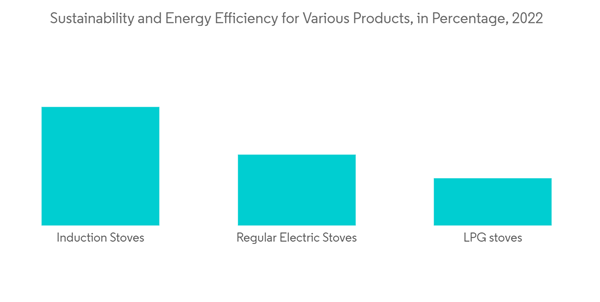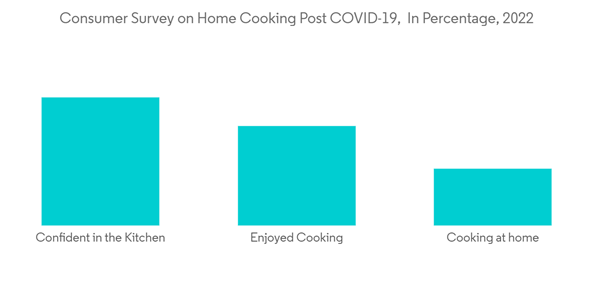The residential Induction Cooktops Market is expected to achieve a CAGR of 6% during the forecast period. The demand for household induction cooktops is high among the urban population, especially in developing nations, due to factors such as high purchasing power, better infrastructural facilities, and an increase in the working population. The rise in fuel prices for conventional gas cooktops and the growth in the trend for modular kitchens, along with the comfort and safety benefits to users, are the major factors that drive the household induction cooktops market.
The persisting COVID-19 pandemic had an impact on the global household induction cooktop market. Consumer electronics demand has been affected by the closure of firms and the cessation of economic activities. Furthermore, China, as one of the biggest manufacturers of electronic components and the hub of the viral spread, caused supply chain and international trade disruptions, limiting market development. However, the normalization of key players' day-to-day operations and the relaxation of rules and regulations imposed by governments in various countries were expected to boost the market during the forecast period.
Household induction cooktops have become more prominent in developing countries due to the rise in the working population and their purchasing power. The use of modular kitchens and the inflation of fuel prices have triggered people to choose an alternative to traditional cookware. An increase in safety and security measures to safeguard people from any fire accidents also hikes up the demand for induction cooktops. The focus on high-tech products and easy-to-use cookware has gained prominence over the years. Various residential construction projects have been on the rise, and people prefer installing induction cooktops more than any other traditional cooking equipment. All these factors are looked at as key drivers for household induction cooktop market growth.
Buyers will appreciate that these cooktops use less energy, which is better for the climate and could even lower electric bills. And more potential buyers are putting energy efficiency at the top of their wish lists when it comes to homes, with buyers considering it a key desirable feature.
As a result, converting LPG stoves to induction stoves can be one of the policy alternatives used by the government of Indonesia to achieve energy sustainability and minimize carbon emissions.
In addition, the rising need for energy efficiency and low operating costs is also fostering the market growth of induction cooktops. For instance, according to the IOP Conference Series on Materials Science and Engineering, electrical energy now dominates household energy demand, which is expected to increase by 50 percent by 2050.
The persisting COVID-19 pandemic had an impact on the global household induction cooktop market. Consumer electronics demand has been affected by the closure of firms and the cessation of economic activities. Furthermore, China, as one of the biggest manufacturers of electronic components and the hub of the viral spread, caused supply chain and international trade disruptions, limiting market development. However, the normalization of key players' day-to-day operations and the relaxation of rules and regulations imposed by governments in various countries were expected to boost the market during the forecast period.
Household induction cooktops have become more prominent in developing countries due to the rise in the working population and their purchasing power. The use of modular kitchens and the inflation of fuel prices have triggered people to choose an alternative to traditional cookware. An increase in safety and security measures to safeguard people from any fire accidents also hikes up the demand for induction cooktops. The focus on high-tech products and easy-to-use cookware has gained prominence over the years. Various residential construction projects have been on the rise, and people prefer installing induction cooktops more than any other traditional cooking equipment. All these factors are looked at as key drivers for household induction cooktop market growth.
Residential Induction Cooktops Market Trends
Sustainability and Energy Efficiency is Driving the Market Growth
The energy efficiency of induction cooktops is one of the most attractive characteristics of this cooking method. Induction cooktops are one of the most energy-efficient appliances, with the energy consumed transferred to the food, compared to electric and gas cooktops.Buyers will appreciate that these cooktops use less energy, which is better for the climate and could even lower electric bills. And more potential buyers are putting energy efficiency at the top of their wish lists when it comes to homes, with buyers considering it a key desirable feature.
As a result, converting LPG stoves to induction stoves can be one of the policy alternatives used by the government of Indonesia to achieve energy sustainability and minimize carbon emissions.
Increasing Demand of Induction Cooktops for Home Cooking is Anticipated to Drive the Market
According to the Brazilian Journal of Nutrition, more than half of the participants in a study of 1,005 people said they cooked more frequently after the pandemic than before.In addition, the rising need for energy efficiency and low operating costs is also fostering the market growth of induction cooktops. For instance, according to the IOP Conference Series on Materials Science and Engineering, electrical energy now dominates household energy demand, which is expected to increase by 50 percent by 2050.
Residential Induction Cooktops Market Competitor Analysis
The report covers major international players operating in the residential induction cooktop market. In terms of market share, a few of the major players currently dominate the market. The residential induction cooktop market is intensely competitive and characterized by the presence of numerous regional and global vendors. The rising number of new vendors will strengthen the competitive environment of the market. These vendors are increasingly competing against each other based on factors such as product quality, technology, product pricing, and product portfolio. Large companies compete through volume purchasing, breadth of products, and effective merchandising and marketing. Small companies focus on a market segment and compete through the depth of their products and superior customer service. Companies including LG Electronics, Inc., Whirlpool Corporation, Panasonic Corporation, Koninklijke Philips N.V., and Robert Bosch GmbH, among others, have a strong presence in the market.Additional Benefits:
- The market estimate (ME) sheet in Excel format
- 3 months of analyst support
Table of Contents
1 INTRODUCTION
4 MARKET DYNAMICS
5 MARKET SEGMENTATION
6 COMPETITIVE LANDSCAPE
Companies Mentioned (Partial List)
A selection of companies mentioned in this report includes, but is not limited to:
- LG Electronics, Inc.
- Whirlpool Corporation
- Panasonic Corporation
- Koninklijke Philips N.V.
- TTK Prestige Ltd
- Sub-Zero Group, Inc.
- Electrolux Group
- Robert Bosch GmbH
- Miele Group
- SMEG S.p.A.
- Daewoo Electronics Corporation
- Fisher & Paykel Appliances Holdings Ltd.
- Glen Dimplex Home Appliances Ltd.
- Videocon Industries Limited
- Bajaj Electricals Ltd
- Haier Group
- Morphy Richards
- Inalsa Appliances
- Kenwood Limited
- Butterfly Gandhimathi Appliances Limited
Methodology

LOADING...










